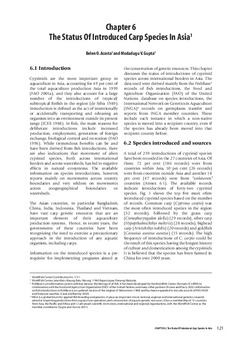The status of introduced carp species in Asia

Citation
Acosta B.O.; Gupta, M.V. (2005). The status of introduced carp species in Asia. p. 121-137. In: Penman, D.J. ; Gupta, M.V. ; Dey, M.M. (eds.) Carp Genetic resources for Aquaculture in Asia. WorldFish Center Technical Report 65. Penang, Malaysia
The Asian countries, in particular Bangladesh, China, India, Indonesia, Thailand and Vietnam, have vast carp genetic resources that are an important element of their aquaculture production systems. Hence, in recent years, the governments of these countries have been recognizing the need to exercise a precautionary approach in the introduction of any aquatic organism, including carps. Information on the introduced species is a prerequisite for implementing programs aimed at Chapter 6 The Status Of Introduced Carp Species In Asia1 Belen O. Acosta2 and Modadugu V. Gupta2 1 WorldFish Center Contribution No. 1731. 2 WorldFish Center, Jalan Batu Maung, Batu Maung, 11960 Bayan Lepas, Penang, Malaysia. 3 FishBase is an information system with key data on the biology of all fish. It has been developed by the WorldFish Center (formerly ICLARM) in collaboration with the Food and Agriculture Organization (FAO) of the United Nations and many other partners (Froese and Pauly 2002). Information on fish introductions in FishBase is an updated version of the original of Welcomme (1988) and has been expanded to include records of FAO, INGA and literature searches. INGA is a global forum for applied fish breeding and genetics. It plays an important role in national, regional and international genetics research aimed at improving productions from aquaculture operations and conservation of aquatic genetic resources. It has a membership of 13 countries from Asia, the Pacific and Africa and 12 advanced scientific institutions, international and regional organizations, with the WorldFish Center as the member coordinator. the conservation of genetic resources. This chapter discusses the status of introductions of cyprinid species across international borders in Asia. The data used were derived mainly from the FishBase3 records of fish introductions, the Food and Agriculture Organization (FAO) of the United Nations database on species introductions, the International Network on Genetics in Aquaculture (INGA) records on germplasm transfer and reports from INGA member countries. These include each instance in which a non-native species is moved into a recipient country, even if the species has already been moved into that recipient country before.
Permalink
Date Available
Type
Publisher
Copyright
CC BY 4.0
Research Themes
Language